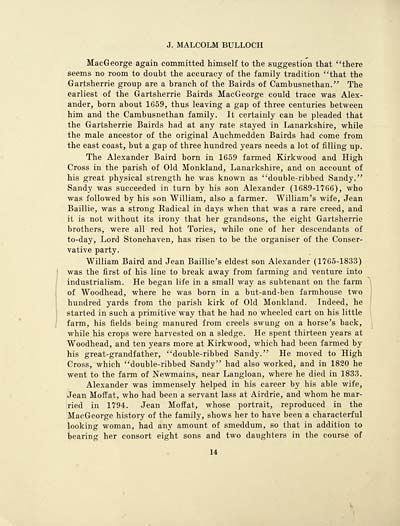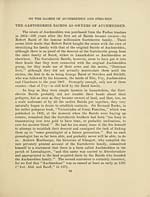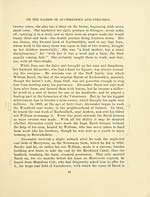Bairds of Auchmedden and Strichen, Aberdeenshire
(18) Page 14
Download files
Complete book:
Individual page:
Thumbnail gallery: Grid view | List view

J. MALCOLM BULLOCH
MacGeorge again committed himself to the suggestion that "there
seems no room to doubt the accuracy of the family tradition "that the
Gartsherrie group are a branch of the Bairds of Cambusnethan." The
earliest of the Gartsherrie Bairds MacGeorge could trace was Alex-
ander, born about 1659, thus leaving a gap of three centuries between
him and the Cambusnethan family. It certainly can be pleaded that
the Gartsherrie Bairds had at any rate stayed in Lanarkshire, while
the male ancestor of the original Auchmedden Bairds had come from
the east coast, but a gap of three hundred years needs a lot of filling up.
The Alexander Baird born in 1659 farmed Kirkwood and High
Cross in the parish of Old Monkland, Lanarkshire, and on account of
his great physical strength he was known as "double-ribbed Sandy."
Sandy was succeeded in turn by his son Alexander (1689-1766), who
was followed by his son William, also a farmer. William's wife, Jean
Baillie, was a strong Radical in days when that was a rare creed, and
it is not without its irony that her grandsons, the eight Gartsherrie
brothers, were all red hot Tories, while one of her descendants of
to-day, Lord Stonehaven, has risen to be the organiser of the Conser-
vative party.
William Baird and Jean Bailhe's eldest son Alexander (1765-1833)
was the first of his line to break away from farming and venture into
industrialism. He began life in a small way as subtenant on the farm
of Woodhead, where he was born in a but-and-ben farmhouse two
hundred yards from the parish kirk of Old Monkland. Indeed, he
started in such a primitive way that he had no wheeled cart on his little
farm, his fields being manured from creels swung on a horse's back,
while his crops were harvested on a sledge. He spent thirteen years at
Woodhead, and ten years more at Kirkwood, which had been farmed by
his great-grandfather, "double-ribbed Sandy." He moved to High
Cross, which "double-ribbed Sandy" had also worked, and in 1820 he
went to the farm of Newmains, near Langloan, where he died in 1833.
Alexander was immensely helped in his career by his able wife,
Jean Moffat, who had been a servant lass at Airdrie, and whom he mar-
ried in 1794. Jean Moffat, whose portrait, reproduced in the
MacGeorge history of the family, shows her to have been a characterful
looking woman, had any amount of smeddum, so that in addition to
bearing her consort eight sons and two daughters in the course of
14
MacGeorge again committed himself to the suggestion that "there
seems no room to doubt the accuracy of the family tradition "that the
Gartsherrie group are a branch of the Bairds of Cambusnethan." The
earliest of the Gartsherrie Bairds MacGeorge could trace was Alex-
ander, born about 1659, thus leaving a gap of three centuries between
him and the Cambusnethan family. It certainly can be pleaded that
the Gartsherrie Bairds had at any rate stayed in Lanarkshire, while
the male ancestor of the original Auchmedden Bairds had come from
the east coast, but a gap of three hundred years needs a lot of filling up.
The Alexander Baird born in 1659 farmed Kirkwood and High
Cross in the parish of Old Monkland, Lanarkshire, and on account of
his great physical strength he was known as "double-ribbed Sandy."
Sandy was succeeded in turn by his son Alexander (1689-1766), who
was followed by his son William, also a farmer. William's wife, Jean
Baillie, was a strong Radical in days when that was a rare creed, and
it is not without its irony that her grandsons, the eight Gartsherrie
brothers, were all red hot Tories, while one of her descendants of
to-day, Lord Stonehaven, has risen to be the organiser of the Conser-
vative party.
William Baird and Jean Bailhe's eldest son Alexander (1765-1833)
was the first of his line to break away from farming and venture into
industrialism. He began life in a small way as subtenant on the farm
of Woodhead, where he was born in a but-and-ben farmhouse two
hundred yards from the parish kirk of Old Monkland. Indeed, he
started in such a primitive way that he had no wheeled cart on his little
farm, his fields being manured from creels swung on a horse's back,
while his crops were harvested on a sledge. He spent thirteen years at
Woodhead, and ten years more at Kirkwood, which had been farmed by
his great-grandfather, "double-ribbed Sandy." He moved to High
Cross, which "double-ribbed Sandy" had also worked, and in 1820 he
went to the farm of Newmains, near Langloan, where he died in 1833.
Alexander was immensely helped in his career by his able wife,
Jean Moffat, who had been a servant lass at Airdrie, and whom he mar-
ried in 1794. Jean Moffat, whose portrait, reproduced in the
MacGeorge history of the family, shows her to have been a characterful
looking woman, had any amount of smeddum, so that in addition to
bearing her consort eight sons and two daughters in the course of
14
Set display mode to:
![]() Universal Viewer |
Universal Viewer | ![]() Mirador |
Large image | Transcription
Mirador |
Large image | Transcription
Images and transcriptions on this page, including medium image downloads, may be used under the Creative Commons Attribution 4.0 International Licence unless otherwise stated. ![]()
| Histories of Scottish families > Bairds of Auchmedden and Strichen, Aberdeenshire > (18) Page 14 |
|---|
| Permanent URL | https://digital.nls.uk/95616779 |
|---|
| Description | A selection of almost 400 printed items relating to the history of Scottish families, mostly dating from the 19th and early 20th centuries. Includes memoirs, genealogies and clan histories, with a few produced by emigrant families. The earliest family history goes back to AD 916. |
|---|

